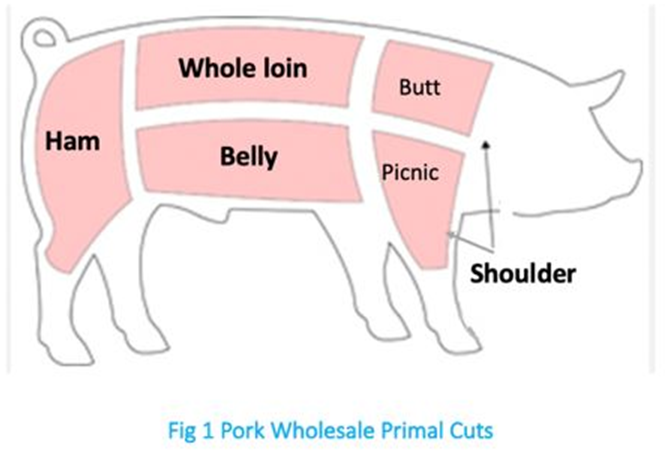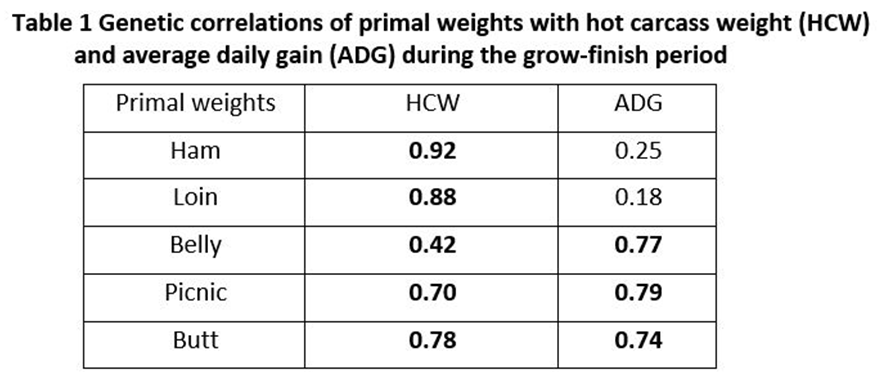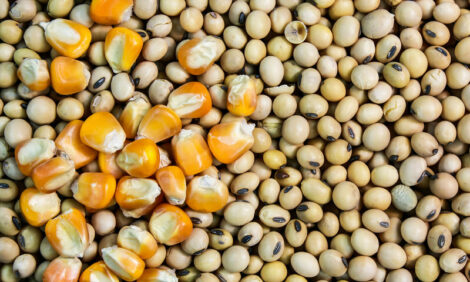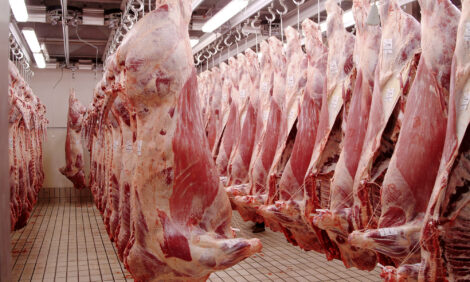



Genesus Global Technical Report: Carcass primals improvement – international market demand
Genesus is developing new pork quality assessment methods to meet the demand of international marketsCanada is a major exporter of pork products, with ~70 percent pork being exported to the US, China, Japan, Mexico and other countries every year (http://cafta.org/agri-food-exports/).
Pork is exported as specific cuts/products or as carcass primals. The four main carcass primals are shoulder (sometimes referred to butt & picnic as two main sub-primals), whole loin, belly and ham (Fig 1.).
Countries have different primal product preferences, thus different primal cuts and pork quality have different values. For example, bacon is a product with strong demand in Canada and the US while Mexico, Spain, Russia and South America prefer ham and shoulder. Japanese consumers prefer both loin and butt, which is a sub-primal product of shoulder (Oh SH and See MT. J. Anim. Sci. 2012, 1: 143-15). South Korean consumers show very strong preferences to pork that is higher in fat, so they have a higher demand for pork belly and shoulder-based cuts (e.g. butt).

There is a difference in composition and pork quality among primals. However, routine objective evaluation of composition and pork quality is usually based on a single point evaluation on the loin, that may not be highly associated with yield and quality in other primals. Genesus, as a global pig genetic company, has been emphasising pork quality improvement since 1998. In 2010, Genesus initiated a project to investigate options to use genomics to improve yield and quality in different primals.
Our results showed that weights of the four primals had medium to high heritability (0.29 – 0.63) indicating reasonable genetic control of primal weights. Hot carcass weight and ADG during the grow-finish period are two important traits in selection programs. All primal weights, except for belly, had high genetic correlations with hot carcass weight. Weights of belly, picnic and butt had high genetic correlations with ADG (Table 1) (Miar et al. J. Anim. Sci. 2014, 92: 2869 – 2884; Miar et al. PLoS ONE. 2014, 9(10): e110105).
These correlations indicate our current selection program, including both hot carcass weight and ADG will also improve primal weights. However, there appears to be further opportunity to improve some specific primal weights, such as the belly primal.

Minolta colour measures, L* (lightness) and a* (redness) are two common objective measures used to evaluate pork colour. A lower L* means darker pork and higher a* means pork that is more red in colour. Ham colours were measured on the three different muscles in the ham primal face, and the average value is reported here. Medium heritability (0.22 – 0.38) has been reported for L* and a* measured on loin and ham primals. Genetic correlations of the colours measured on loin and measured on ham was 0.50 for L* and 0.51 for a* (Miar et al. J. Anim. Sci. 2014, 92: 2869 – 2884).
These findings suggest that the usual evaluation of pork colour using loin measures is positively correlated with ham colours however improvement of ham colour will only be moderately successful by selecting on loin colour.
To continue to improve the yield and quality of carcass primals and important cuts, Genesus is developing a new project focusing on more accurate measurement technology and genetic improvement options using genomic tools in both commercial and purebred pigs. Along with the increase of our genomic database, we aim to sort out a more efficient genomic strategy to improve specific primal composition and quality.
As a global pig genetic company, we believe this effort will contribute to meeting the variety of customer demands for pork all over the world.







